The revival of Flipside
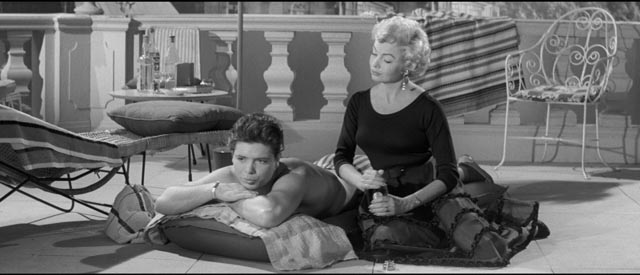
satirical musical Expresso Bongo (1959)
It was a surprise to realize that two years had passed since the last BFI Flipside release – Bill Forsythe’s That Sinking Feeling (1979) — and yet another five months before that for Schalcken the Painter (1979). The BFI has gone some way to make up for the long delay by simultaneously releasing three new Flipside titles on April 25. Two of these new releases are somewhat complementary – black-and-white “youth oriented” movies from 1959 – while the other is an obscure anomaly from 1974. All three offer impressive visual presentations (with one being slightly problematic) and a wealth of supplements.
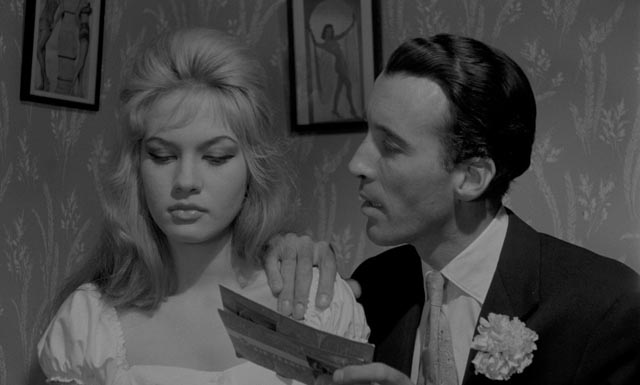
in Edmond T. Greville’s Beat Girl (1959)
Beat Girl (Edmond T. Greville, 1959)
Filmmaker Edmond T. Greville’s career went back to the silent period, as actor, writer, assistant director and eventually director in his own right. He had worked with Abel Gance, Rene Clair, Josephine Baker and Erich von Stroheim, moving back and forth between France and England. He was apparently considered something of a stylist and his work was notable for its erotic content. Perhaps he considered it something of a comedown by 1959 to be making what was essentially a sordid exploitation movie in London. Star Gillian Hills, who plays rebellious teen Jennifer Linden, mentions in an interview on the disk that Greville didn’t seem to be much in sympathy with the material during the shoot.
Jennifer is something of a spoiled rich girl, angered at her father’s neglect after her mother’s death and resentful when he brings a new young wife home from France. Although attending art school, Jenny prefers to spend her time hanging out at coffee houses with her beatnik friends, listening to music and dancing. When her new stepmother Nichole (Noelle Adam) tries to make a conciliatory gesture by joining Jenny for lunch, the girl creates an embarrassing scene. Then, as Nichole is leaving the cafe, she bumps into another woman coming in. This is Greta (Delphi Lawrence), who happens to be the woman in charge of the girls at a Soho strip club across the street. Although Nichole brushes the woman off, Jenny notices the moment between them and finds herself armed with a weapon she can use against her stepmother.
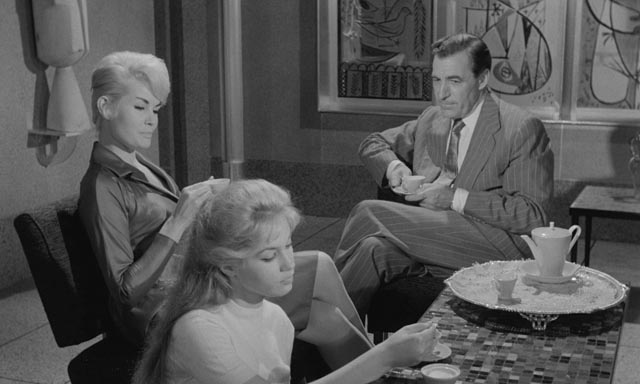
When she goes to the strip club, allowed in despite her age because she pretends to be a friend of Greta’s, Jenny discovers a world she had no previous knowledge of. As various women perform elaborate, teasing dances – surprisingly suggestive for the time – an audience of mostly older men sit quietly in theatre-style seats and stare. While Jenny tries to pry information about Nichole out of Greta, she comes to the notice of club owner Kenny King (a rather sleazy Christopher Lee), who is immediately interested in her, and not just as a potential performer.
Meanwhile back at home, Jenny’s anger at her father becomes more open – he’s an architect with grandiose plans to build a city of the future (for which he seems to have found South American backers), a vision which seems more inhuman dystopia than human paradise. Jenny begins to drop hints about Nichole’s sordid past (a mixture of showgirl and prostitute), more to force her father to pay attention to her than anything else, Nichole merely providing a handy weapon.
Things come to a head when Jenny brings a crowd of her beatnik friends home for a party, trashing the coldly formalist townhouse as they booze, dance and make out. Jenny, in order to provoke Nichole even more, does an impromptu striptease. Which is the point at which her father comes home. He kicks everyone out and, completely bewildered by his daughter’s incomprehensible behaviour, slaps Jenny’s face.
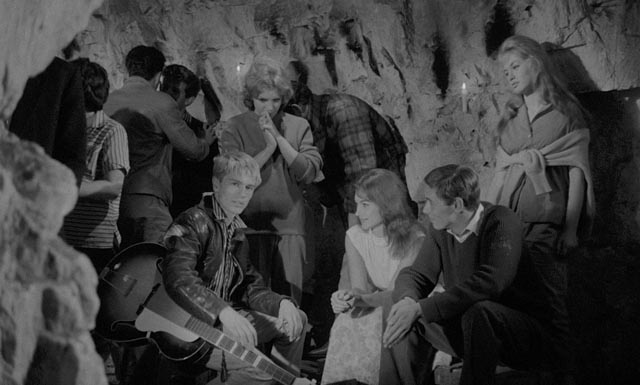
Not surprisingly, she runs away from home and goes to the one place which might hurt her father most: the strip club, where Kenny King proposes that she fly to Europe with him. Things come to a head with grim consequences and the movie ends with a kind of restoration of the conventional middle class family.
Like so many films of the period which ostensibly dealt with juvenile delinquency and youth revolt, Beat Girl toys with transgressive elements but is at heart deeply conservative. Yes, the adults need to learn some lessons too, but the chief aim is to have the kids learn their proper place in the scheme of things and to defer to the wisdom of their elders.
Although Beat Girl lacks the kind of existential depths sought by something like Rebel Without a Cause, playing more at the level of an Albert Zugsmith exploitation B movie, it has some fine black-and-white photography by Walter Lassally, close to the start of what would be a long and prestigious feature film career after working on many documentary shorts throughout the ’50s. It also has an interesting cast, with David Farrar as Jenny’s father, Lee as the villain, Nigel Green as Kenny King’s right-hand man and Oliver Reed, Adam Faith and Shirley Anne Field as key members of the beatnik crowd grooving on John Barry’s musical blend of jazz and rock’n’roll. (Barry, two years away from becoming the legendary composer of the James Bond theme, was brought onto the project by Faith, with whom he had a successful recording partnership at the time.) Faith has real presence both as an actor and singer, helping to lend a touch of authenticity to the film’s rebellious subculture.
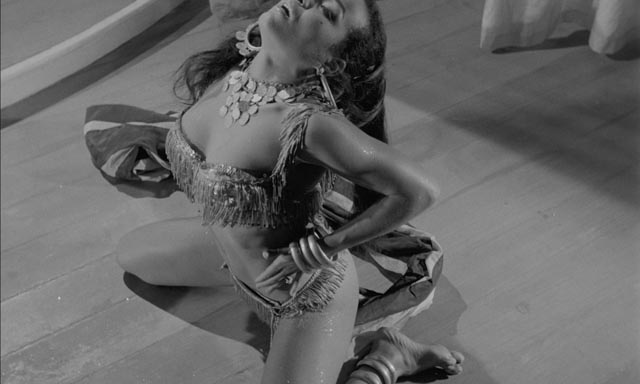
Gillian Hills, who was just fifteen when she made the film and had previously only had a small part in Roger Vadim’s Les Liaisons Dangereuses (1959), gives an intense and angry performance as Jenny which calls to mind that famous line delivered by Brando in The Wild One: when asked “what are you rebelling against?”, Brando’s Johnny Strabler sneers, “What’ve you got?” Although narratively justified by her father’s preoccupation with his work, her emotions seem more like an archetypal expression of generational conflict.
Beat Girl was the most notable screenwriting credit of Dail Ambler, a pseudonym for writer Betty Mabel Lilian Williams, a former reporter who had a very prolific post-war career writing hard-boiled detective novels for the pulp market, apparently as tough and nasty as Mickey Spillane. The script’s sympathies obviously reside more with the beatniks and the seamy denizens of the coffee houses and strip clubs than with the stuffy middle class, and towards the end, to create a favourable contrast, Ambler introduces an element soon to displace the relatively benign beatniks in the form of three vicious Teddy boys who express a much more nihilistic and violent attitude towards society.
*
The BFI disk presents no less than three versions of the feature – the original theatrical cut, an alternative version with a couple of additional scenes but toned down strip routines, and a third which combines both (the more suggestive strip sequences plus the additional scenes). There’s a 25-minute, somewhat rambling interview with Gillian Hills about the experience of making the film; a couple of striptease shorts, Beauty in Brief (1955) and Goodnight with Sabrina (1958), which actually seem much tamer than the sequences in the feature; and a short film by John Fitchen, Cross-Roads (1955). This is a ghost story starring Christopher Lee which is perhaps most notable for what may well be the first instance of a looming close up of the piercing stare which would soon become a signature element of his appearances as Dracula. This last also features a supporting appearance by Ferdy Mayne, destined himself to make his own mark as an impressive vampire count twelve years later in Roman Polanski’s The Fearless Vampire Killers (1967).
*
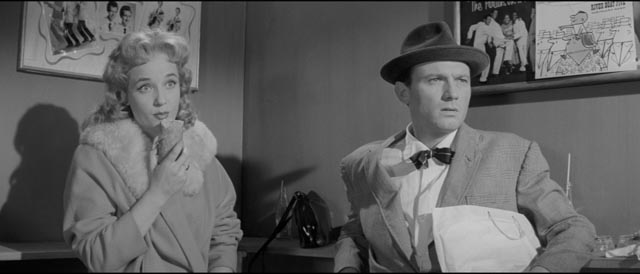
Expresso Bongo (Val Guest, 1959)
I’ve written here before about Val Guest, one of my favourite underrated British filmmakers, whose versatile career spanned many genres – horror, science fiction, crime, thriller, comedy, war – always marked by a documentary-like attention to the details of setting and character. He brought his usual sensibility to his one “youth” picture, 1959’s Expresso Bongo, much of which was shot around London’s seedy Soho area. But although the setting is similar to Beat Girl’s, this is not a juvenile delinquency story.
Based on a stage production written by Wolf Mankowitz and Julian More, it’s a satire on the pop music business whose protagonist is an ambitious schemer named Johnny Jackson (Laurence Harvey), an agent and promoter with more than a passing resemblance to Tony Curtis’ Sidney Falco in Alexander Mackendrick’s Sweet Smell of Success (1957). Johnny’s girlfriend is Maisie King (Sylvia Syms), a largely talent-free singer/dancer in a Soho strip club. One evening when she insists he take her out dancing, he comes across a kid jamming with the band. Bert Rudge just wants to play the bongos, but when he breaks out in a song, Johnny smells potential profit. He pursues the working class Bert and signs him to a dubious contract, then sets out to manipulate his connections in the recording business, particularly producer Mayer (Meier Tzelniker), to launch the kid’s career as Bongo Herbert.
Rooted in the East End of Mankowitz’s own background, Expresso Bongo is packed with character types which verge on caricature, but remain vitally alive thanks to the excellent cast. Harvey was seldom if ever this energetic in any other performance, spilling out where he was more often tightly contained, modelling his accent and style on Mankowitz himself (who came from a family of Russian Jewish immigrants).
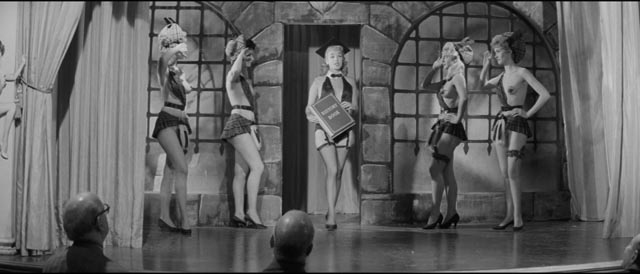
As Bongo Herbert begins his climb in the business, Johnny finds himself fending off a number of other people interested in exploiting him, including an ageing American performer (Guest’s wife Yolande Donlan), whose protective instincts slide from motherly concern towards something more sexual. Johnny’s hold begins to slip when it becomes clear that his original contract is not merely excessively exploitative but also invalid because Herb is underage. But as he loses his hold, he starts looking for other chances.
Bongo Herbert is played by Cliff Richard, who had only one small supporting role in a previous film (Terence Young’s Serious Charge, also 1959). Eighteen at the time, Richard was already a major star in England, backed by his band The Shadows (who also appear in the film). Bongo Herbert isn’t exactly a rocker though; his musical numbers here are softer ballads, one of which (“The Shrine on the Second Floor”) even hints at his eventual move to middle-of-the-road pop rooted in his Christian faith. At this distance, I have to say that Herbert is not entirely convincing as a rock’n’roll rebel, the film relying on Richard’s then current star status to give weight to the rather mild musical numbers. Perhaps Expresso Bongo would have been a bit stronger with someone like Adam Faith in the role, someone with an edgier, less clean-cut persona.
Seeing the film again in this new BFI Blu-ray edition turned out to be disorienting. I first saw it almost fifteen years ago on DVD and back then it seemed like a well-crafted portrait of a time and a place and a business which was only then taking shape. This second viewing repeatedly confounded me with moments and sequences of which I had absolutely no memory. Because it turns out that while the version I’d previously seen contained only Cliff Richard’s performances, fully justified within the narrative, and the brief musical numbers in Maisie’s strip club (again, surprisingly suggestive, particularly in a mainstream feature with a major cast), Expresso Bongo is actually a full-blown musical.
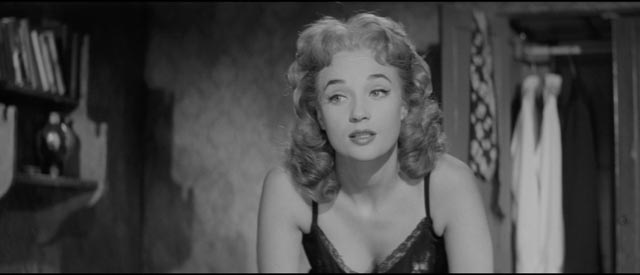
Here, in the BFI edition, other characters break out into song in classical musical style, expressing their feelings in completely non-naturalistic vocals backed by unseen musicians. One of the high points is a duet between Harvey and Tzelniker as the latter expresses his dislike of new music in a number called “Nausea” while the two of them walk down a Soho street. How the heck did I not remember any of this?
Well, it turns out that in 1962 the film was re-cut for a second release, removing all musical numbers except for Richard’s performances, to cash in on his increased popularity, and this was the version I saw on that original DVD. So the BFI edition was virtually an entirely new film for me. Interestingly, the disk includes the 1962 version, which is accompanied by a commentary from Guest, Donlan and film historian Marcus Hearn, recorded in 2005, in which they all at some point express confusion about what they are watching – Hearn repeatedly refers to the script which included sequences not in the cut and questions whether they were ever filmed, while Guest wonders where things disappeared to. Although the later cut actually seems closer to Guest’s typical documentary style, the original cut is much livelier, bringing out more of the underlying comedy.
*
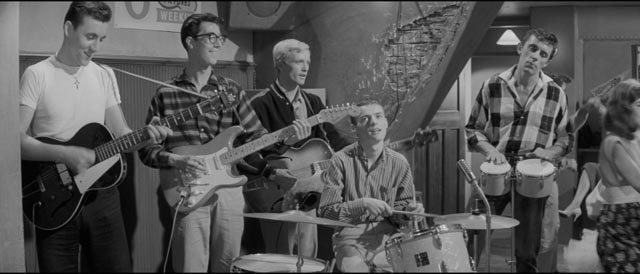
The 2K transfer from the original negative looks terrific, showcasing Guest’s skills with the 2.35:1 frame and cinematographer John Wilcox’s fine handling of night shooting on the streets of Soho as well as atmospheric studio interiors. In addition to the 1962 re-release version with commentary, there’s a gallery of promotional materials (with UK and US press books as PDFs on the DVD which is included with the Blu-ray), and two additional short films.
Youth Club (Norman Prouting, 1954) is a Central Office of Information documentary promoting positive activities for aimless post-war youth in clubs which offer educational opportunities, training in trades and engagement with the community. Strangely, the film was not made for use within the UK, but was rather exported to other countries as if its purpose wasn’t to encourage responsible citizenship but rather to convey a reassuring image of British social stability to foreigners.
The Square (1957) is of real interest as the first film of Michael Winner, transcending its technical limitations to create an image of post-war London where physical damage to the city and the gradual transformation wrought by controlled urban planning turn out not to have undermined the mutually supportive community of working class people. The film is cast in the form of the reminiscence of an elderly man (the venerable A.E. Matthews, towards the end of a film career which began in 1914) who has lived most of his life in a house on an East End square, once prosperous, now in decay, surrounded by the ruins of war. The tone is melancholy, particularly when he finds out that with the appropriation of his house for development, he will have to go into a home where he won’t be allowed to keep his dog.
But just before his forced move, all his neighbours gather for a big street party in his honour, to recognize his long-time presence in the community; a skiffle band provides the music and a young girl even gets him up and dancing, while others give him gifts. On the day of the move, a neighbour takes his dog in, promising to look after it so that he can come back and visit any time.
The Square, written, produced and directed by Winner when he was 22, already shows his sensitivity to English social life which was one of the strengths of his early features from West 11 (1963) through I’ll Never Forget What’s’isname (1967).
*
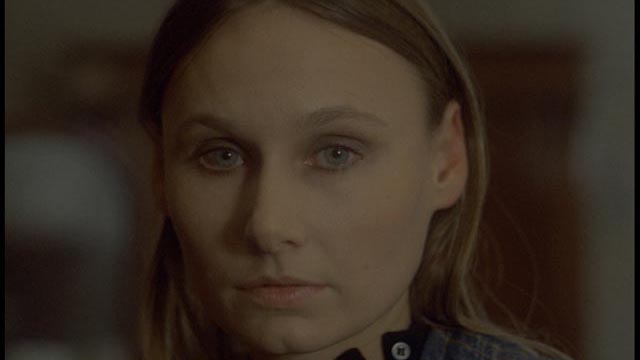
Symptoms (José Ramón Larraz, 1974)
While Beat Girl and Expresso Bongo share a specific time and milieu, the third of the new Flipside releases is very different. A low budget horror film made in England by a Catalan director, Symptoms pretty much disappeared after surprisingly making its debut as the official British entry in competition at Cannes in 1974. How that came about is not made clear in the supplements provided by the BFI for their release, but with the advent of home video the film apparently became much sought after by collectors. Director José Ramón Larraz is best known for Vampyres (1974), a potent mix of sex and horror also made in England, in which a pair of female vampires snare and toy with various travellers who wander near their country house. Stylish and trashy in equal parts, Vampyres is one of the key exploitation films of its era.
Symptoms, made earlier the same year, turns out to be even more stylish and somewhat less trashy. But it’s still a story of female-centred horror driven by lesbian desire. Sexual repression is one of the fundamental tenets of horror, a source of derangement and madness which is frequently expressed through violence. And not surprisingly in a more or less patriarchal culture, female sexuality is viewed as particularly disturbing. Whether in this case the narrative constitutes a critique of the way in which the female is damaged by that patriarchy or is simply a reactionary expression of distrust of the feminine, I’m not sure, but the film is an effective variation on the personality horror which became something of its own genre after Hitchcock unleashed the murderous gender confusion of Psycho in 1960.
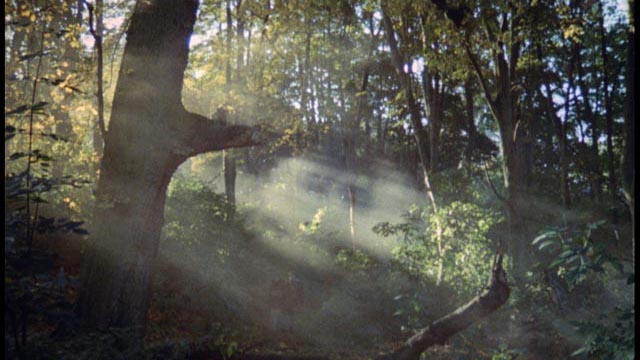
Helen (Angela Pleasence), a young woman returning from an unspecified convalescence in Switzerland, arrives at her country house with friend Anne (Lorna Heilbron) to continue her recovery. But Larraz has already set a disturbing tone in the first few moments with glimpses of a dead body tangled in weeds at the edge of the nearby lake and an ominous man who turns out to be the groundskeeper Brady (Peter Vaughan). While Helen appears nervous, somewhat neurotic, vague hints are given of something involving her friend Cora (Marie-Paul Mailleux), whom local people are surprised to learn hasn’t returned with her.
It isn’t long before we realize that the body in the lake is Cora, and that she was – shall we say? – a “special friend” who may have betrayed Helen by becoming sexually involved with Brady. As Helen becomes more possessively attached to Anne, who has recently broken off with her own boyfriend, Cora seems to be haunting the house. The situation with Anne, who turns out to be seeking a reconciliation with her boyfriend, begins to echo the earlier situation with Cora, driving Helen deeper into her madness with inevitable consequences.
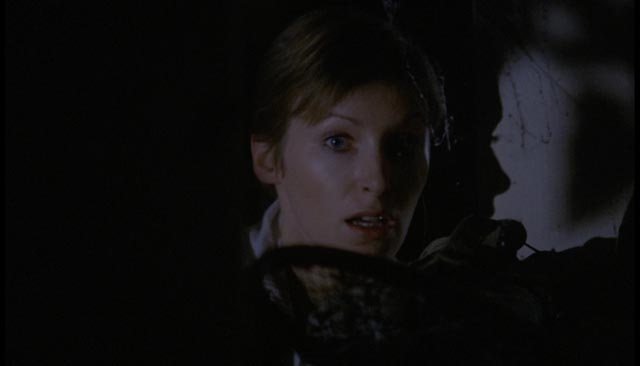
Although Symptoms is unsurprising in many respects, following a fairly familiar formula, Larraz knows how to make the most of the material, effectively blending idyllic-seeming days in the woods and on the lake with nights full of shadows and suggestive sounds. But what really raises the film above its generic trappings is the excellent cast, particularly the strangely ethereal Pleasence (daughter of Donald), whose pale, fragile features convey remarkable depths of confusion about her own desires. Every minute movement of her eyes reveals subtly shifting emotions, tying the viewer very closely to her perception of events so that we follow her into her madness and remain uncomfortably sympathetic even as she becomes violent.
Like many films made by non-native filmmakers, Symptoms transforms the familiar into something strange. This is particularly useful for horror, as evidenced by Roman Polanski’s depiction of London in Repulsion and Lindisfarne in Cul-de-sac, and by Jorge Grau’s evocation of the Peak District in The Living Dead at Manchester Morgue. Here, Larraz uses soft, vibrant pastel colours to give a typical country house and the misty surrounding woods and lake a fairy tale atmosphere; but in this story the threat turns out not to be the ogre lurking in the woods, but rather the princess in the tower.
*
While Symptoms is certainly worthy of revival and Flipside offers a suitable venue, there are some puzzling aspects to the film’s presentation on the disk. The original negative, long thought to be lost, was discovered in 2014 and the BFI helped to rescue it in collaboration with the film’s producer Jean Luc Dupuis and the Belgian Cinematek. Following restoration by the Cinemtek, a hi-def master was delivered to the BFI.
The restoration notes claim that the presentation is in the original aspect ratio, but it seems doubtful that a commercial project like this would have been intended for projection at 1.33:1 in 1974 when it would be extremely unlikely that any theatre would be showing it without using a matted aperture. The opening titles are clearly framed for a wider aperture, possibly 1.66:1, which was common in Britain, or even 1.85:1 as IMDb claims. When I zoomed the image in on my HD television, the framing seemed quite comfortable throughout the film, making the images tighter and more focused than they seem in the open-matte framing of the disk. It seems strange that the BFI, usually sensitive to such issues, would somehow not notice that the internal evidence of the film’s imagery indicates that it was intended to be shown with a wider frame. With the extra head and foot room trimmed, the film has far greater impact; in open-matte, it plays more like a highly polished episode of Brian Clemens’ Thriller series from the mid ’70s.
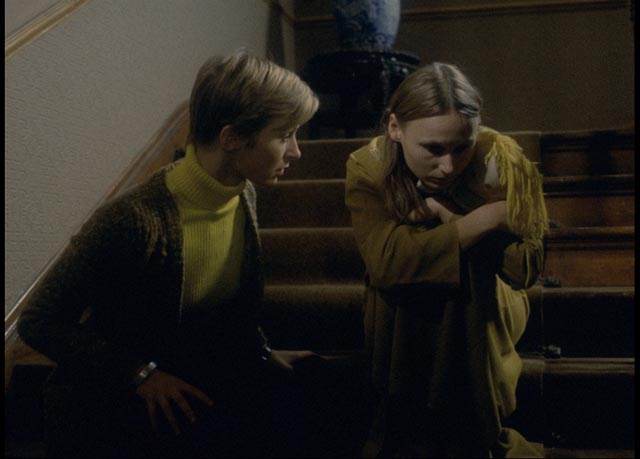
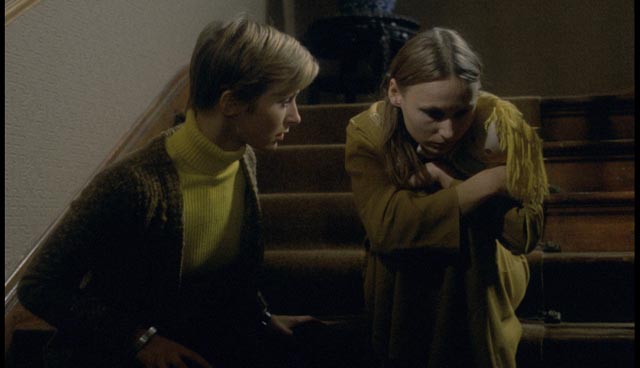
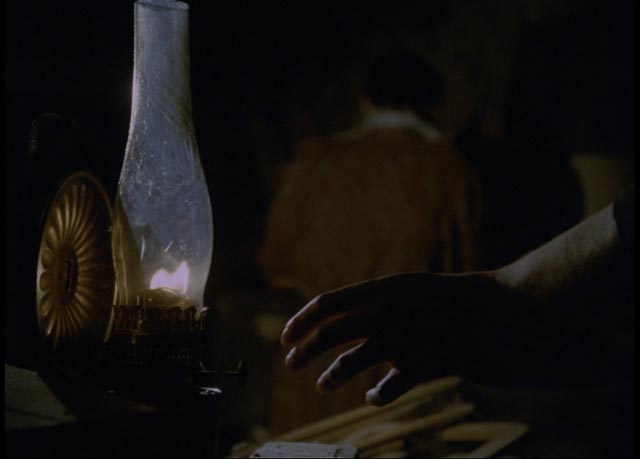
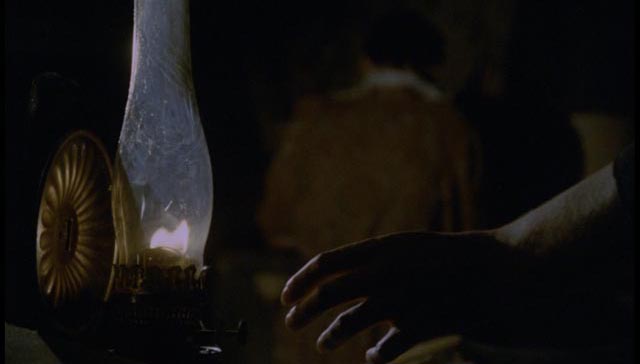
In addition to the framing issue, the image in many places has the waxy appearance of excessive digital noise reduction, with the film grain smoothed away. But despite this, the film has a pleasing colour palette and the softening effect gives the exteriors a dreamy quality.
The disk also has some fairly substantial supplements, including new interviews with Angela Pleasence (10:00), Lorna Heilbron (18:00) and editor Brian Smedley-Aston (17:00), who went on to produce Vampyres.
From Barcelona … to Tunbridge Wells: The Films of Jose Larraz (24:00, 1999) is an episode of the Channel 4 series Eurotika! in which Andy Stark and Pete Tombs survey the director’s career, which was split between England and Spain over a period of thirty years.
On Vampyres and Other Symptoms (74:00, 2011) is a feature-length documentary which focuses on Larraz’s two most famous films as it follows him on a trip to Sitges in 2009 where he received a lifetime achievement award. Made by Celia Novis, it offers some interesting glimpses of Larraz’s thoughts on horror and filmmaking in general, but unfortunately Novis seems more interested in being “creative” than in conveying much solid information; she uses lengthy excerpts from the two features into which she intercuts shots of Larraz, giving the impression that he is a part of the images he himself created, while every now and then we get short clips from an interview. Despite the running time, it leaves a frustrating impression of barely scratching the surface of its subject.
Comments